Angela Fan
Jack
Stress Testing Deliberative Alignment for Anti-Scheming Training
Sep 19, 2025



Abstract:Highly capable AI systems could secretly pursue misaligned goals -- what we call "scheming". Because a scheming AI would deliberately try to hide its misaligned goals and actions, measuring and mitigating scheming requires different strategies than are typically used in ML. We propose that assessing anti-scheming interventions requires at least (1) testing propensity to scheme on far out-of-distribution (OOD) tasks, (2) evaluating whether lack of scheming is driven by situational awareness, and (3) checking for robustness to pre-existing misaligned goals. We use a broad category of "covert actions" -- such as secretly breaking rules or intentionally underperforming in tests -- as a proxy for scheming, and design evaluations for covert actions. We then stress-test deliberative alignment as a case study for anti-scheming. Across 26 OOD evaluations (180+ environments), deliberative alignment reduces covert action rates (OpenAI o3: 13%->0.4%) but does not fully eliminate them. Our mitigation is also able to largely stop agents from pursuing a hidden goal previously trained into the model, but we still find misbehavior after additional red-teaming. We find that models' chain-of-thought (CoT) often demonstrates awareness of being evaluated for alignment, and show causal evidence that this awareness decreases covert behavior, while unawareness increases it. Therefore, we cannot exclude that the observed reductions in covert action rates are at least partially driven by situational awareness. While we rely on human-legible CoT for training, studying situational awareness, and demonstrating clear evidence of misalignment, our ability to rely on this degrades as models continue to depart from reasoning in standard English. We encourage research into alignment mitigations for scheming and their assessment, especially for the adversarial case of deceptive alignment, which this paper does not address.
The Llama 3 Herd of Models
Jul 31, 2024Abstract:Modern artificial intelligence (AI) systems are powered by foundation models. This paper presents a new set of foundation models, called Llama 3. It is a herd of language models that natively support multilinguality, coding, reasoning, and tool usage. Our largest model is a dense Transformer with 405B parameters and a context window of up to 128K tokens. This paper presents an extensive empirical evaluation of Llama 3. We find that Llama 3 delivers comparable quality to leading language models such as GPT-4 on a plethora of tasks. We publicly release Llama 3, including pre-trained and post-trained versions of the 405B parameter language model and our Llama Guard 3 model for input and output safety. The paper also presents the results of experiments in which we integrate image, video, and speech capabilities into Llama 3 via a compositional approach. We observe this approach performs competitively with the state-of-the-art on image, video, and speech recognition tasks. The resulting models are not yet being broadly released as they are still under development.
Effective Long-Context Scaling of Foundation Models
Sep 27, 2023



Abstract:We present a series of long-context LLMs that support effective context windows of up to 32,768 tokens. Our model series are built through continual pretraining from Llama 2 with longer training sequences and on a dataset where long texts are upsampled. We perform extensive evaluation on language modeling, synthetic context probing tasks, and a wide range of research benchmarks. On research benchmarks, our models achieve consistent improvements on most regular tasks and significant improvements on long-context tasks over Llama 2. Notably, with a cost-effective instruction tuning procedure that does not require human-annotated long instruction data, the 70B variant can already surpass gpt-3.5-turbo-16k's overall performance on a suite of long-context tasks. Alongside these results, we provide an in-depth analysis on the individual components of our method. We delve into Llama's position encodings and discuss its limitation in modeling long dependencies. We also examine the impact of various design choices in the pretraining process, including the data mix and the training curriculum of sequence lengths -- our ablation experiments suggest that having abundant long texts in the pretrain dataset is not the key to achieving strong performance, and we empirically verify that long context continual pretraining is more efficient and similarly effective compared to pretraining from scratch with long sequences.
Ngambay-French Neural Machine Translation (sba-Fr)
Aug 25, 2023

Abstract:In Africa, and the world at large, there is an increasing focus on developing Neural Machine Translation (NMT) systems to overcome language barriers. NMT for Low-resource language is particularly compelling as it involves learning with limited labelled data. However, obtaining a well-aligned parallel corpus for low-resource languages can be challenging. The disparity between the technological advancement of a few global languages and the lack of research on NMT for local languages in Chad is striking. End-to-end NMT trials on low-resource Chad languages have not been attempted. Additionally, there is a dearth of online and well-structured data gathering for research in Natural Language Processing, unlike some African languages. However, a guided approach for data gathering can produce bitext data for many Chadian language translation pairs with well-known languages that have ample data. In this project, we created the first sba-Fr Dataset, which is a corpus of Ngambay-to-French translations, and fine-tuned three pre-trained models using this dataset. Our experiments show that the M2M100 model outperforms other models with high BLEU scores on both original and original+synthetic data. The publicly available bitext dataset can be used for research purposes.
Llama 2: Open Foundation and Fine-Tuned Chat Models
Jul 19, 2023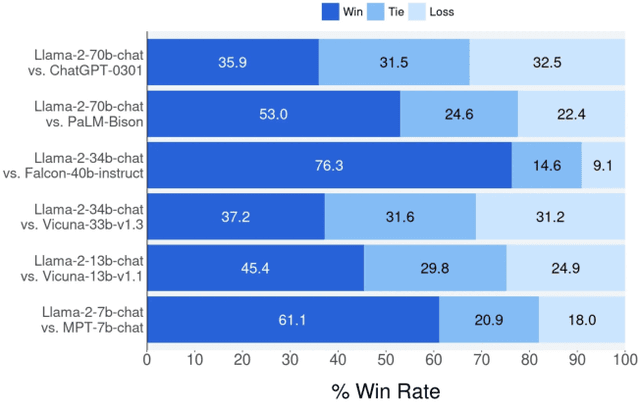

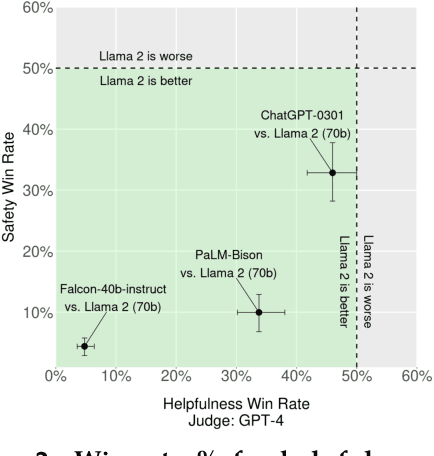

Abstract:In this work, we develop and release Llama 2, a collection of pretrained and fine-tuned large language models (LLMs) ranging in scale from 7 billion to 70 billion parameters. Our fine-tuned LLMs, called Llama 2-Chat, are optimized for dialogue use cases. Our models outperform open-source chat models on most benchmarks we tested, and based on our human evaluations for helpfulness and safety, may be a suitable substitute for closed-source models. We provide a detailed description of our approach to fine-tuning and safety improvements of Llama 2-Chat in order to enable the community to build on our work and contribute to the responsible development of LLMs.
Revisiting Machine Translation for Cross-lingual Classification
May 23, 2023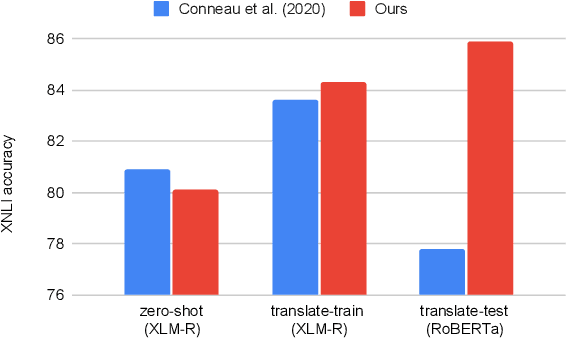
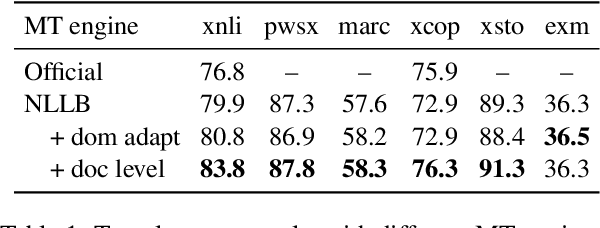

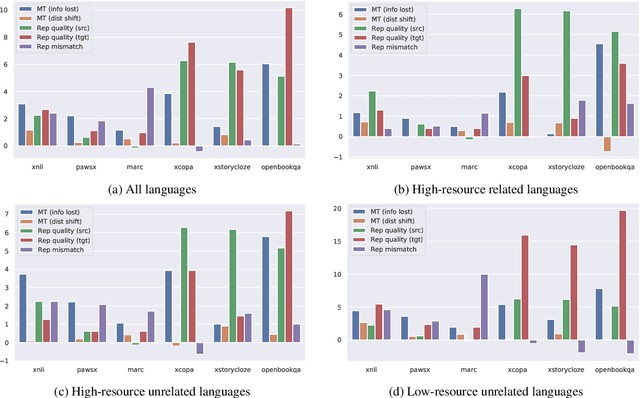
Abstract:Machine Translation (MT) has been widely used for cross-lingual classification, either by translating the test set into English and running inference with a monolingual model (translate-test), or translating the training set into the target languages and finetuning a multilingual model (translate-train). However, most research in the area focuses on the multilingual models rather than the MT component. We show that, by using a stronger MT system and mitigating the mismatch between training on original text and running inference on machine translated text, translate-test can do substantially better than previously assumed. The optimal approach, however, is highly task dependent, as we identify various sources of cross-lingual transfer gap that affect different tasks and approaches differently. Our work calls into question the dominance of multilingual models for cross-lingual classification, and prompts to pay more attention to MT-based baselines.
RQUGE: Reference-Free Metric for Evaluating Question Generation by Answering the Question
Nov 09, 2022Abstract:Existing metrics for evaluating the quality of automatically generated questions such as BLEU, ROUGE, BERTScore, and BLEURT compare the reference and predicted questions, providing a high score when there is a considerable lexical overlap or semantic similarity between the candidate and the reference questions. This approach has two major shortcomings. First, we need expensive human-provided reference questions. Second, it penalises valid questions that may not have high lexical or semantic similarity to the reference questions. In this paper, we propose a new metric, RQUGE, based on the answerability of the candidate question given the context. The metric consists of a question-answering and a span scorer module, in which we use pre-trained models from the existing literature, and therefore, our metric can be used without further training. We show that RQUGE has a higher correlation with human judgment without relying on the reference question. RQUGE is shown to be significantly more robust to several adversarial corruptions. Additionally, we illustrate that we can significantly improve the performance of QA models on out-of-domain datasets by fine-tuning on the synthetic data generated by a question generation model and re-ranked by RQUGE.
BLOOM: A 176B-Parameter Open-Access Multilingual Language Model
Nov 09, 2022Abstract:Large language models (LLMs) have been shown to be able to perform new tasks based on a few demonstrations or natural language instructions. While these capabilities have led to widespread adoption, most LLMs are developed by resource-rich organizations and are frequently kept from the public. As a step towards democratizing this powerful technology, we present BLOOM, a 176B-parameter open-access language model designed and built thanks to a collaboration of hundreds of researchers. BLOOM is a decoder-only Transformer language model that was trained on the ROOTS corpus, a dataset comprising hundreds of sources in 46 natural and 13 programming languages (59 in total). We find that BLOOM achieves competitive performance on a wide variety of benchmarks, with stronger results after undergoing multitask prompted finetuning. To facilitate future research and applications using LLMs, we publicly release our models and code under the Responsible AI License.
No Language Left Behind: Scaling Human-Centered Machine Translation
Jul 11, 2022
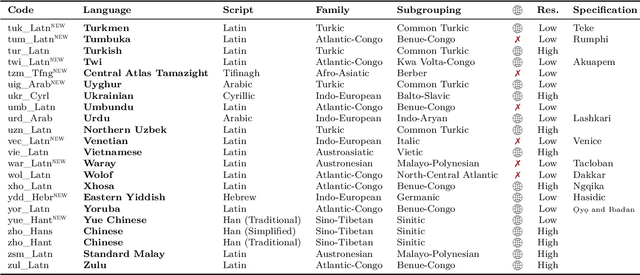
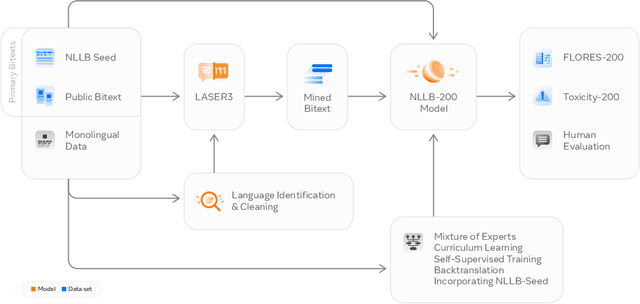

Abstract:Driven by the goal of eradicating language barriers on a global scale, machine translation has solidified itself as a key focus of artificial intelligence research today. However, such efforts have coalesced around a small subset of languages, leaving behind the vast majority of mostly low-resource languages. What does it take to break the 200 language barrier while ensuring safe, high quality results, all while keeping ethical considerations in mind? In No Language Left Behind, we took on this challenge by first contextualizing the need for low-resource language translation support through exploratory interviews with native speakers. Then, we created datasets and models aimed at narrowing the performance gap between low and high-resource languages. More specifically, we developed a conditional compute model based on Sparsely Gated Mixture of Experts that is trained on data obtained with novel and effective data mining techniques tailored for low-resource languages. We propose multiple architectural and training improvements to counteract overfitting while training on thousands of tasks. Critically, we evaluated the performance of over 40,000 different translation directions using a human-translated benchmark, Flores-200, and combined human evaluation with a novel toxicity benchmark covering all languages in Flores-200 to assess translation safety. Our model achieves an improvement of 44% BLEU relative to the previous state-of-the-art, laying important groundwork towards realizing a universal translation system. Finally, we open source all contributions described in this work, accessible at https://github.com/facebookresearch/fairseq/tree/nllb.
A Few Thousand Translations Go a Long Way! Leveraging Pre-trained Models for African News Translation
May 04, 2022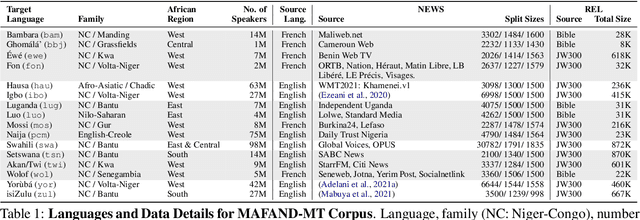
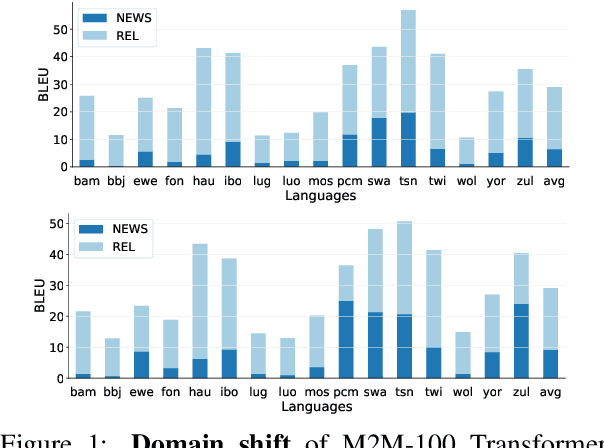
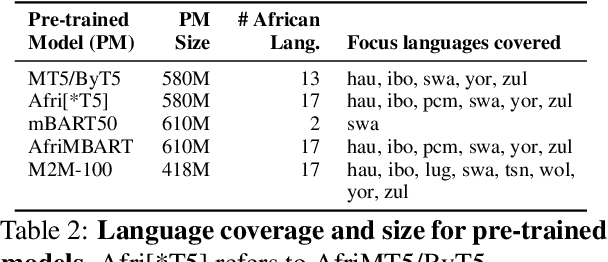

Abstract:Recent advances in the pre-training of language models leverage large-scale datasets to create multilingual models. However, low-resource languages are mostly left out in these datasets. This is primarily because many widely spoken languages are not well represented on the web and therefore excluded from the large-scale crawls used to create datasets. Furthermore, downstream users of these models are restricted to the selection of languages originally chosen for pre-training. This work investigates how to optimally leverage existing pre-trained models to create low-resource translation systems for 16 African languages. We focus on two questions: 1) How can pre-trained models be used for languages not included in the initial pre-training? and 2) How can the resulting translation models effectively transfer to new domains? To answer these questions, we create a new African news corpus covering 16 languages, of which eight languages are not part of any existing evaluation dataset. We demonstrate that the most effective strategy for transferring both to additional languages and to additional domains is to fine-tune large pre-trained models on small quantities of high-quality translation data.
 Add to Chrome
Add to Chrome Add to Firefox
Add to Firefox Add to Edge
Add to Edge